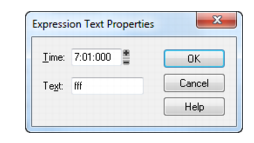Expression marks tell a performer how to interpret the notes and durations on the page. They provide a necessary supplement to simple notation, in which notes have only pitch and duration, but no hint of how loudly, softly, or smoothly, they are to be played. Dynamic marks—from ppp (pianissimo) for “very, very softly” through fff (fortissimo) for “very, very forcefully”—allow notation to convey volume instructions. Expression marks are also needed to specify other aspects of performance, such as whether a passage is to be played legato or staccato. Finally, expression marks can be used to convey to the performer the composer's suggestions or requirements as to how a passage should be interpreted. In such cases the language used can leave much to the imagination, as in with majesty or abrasively.Expression marks do not change the underlying MIDI data. They only provide information to the reader on how a piece should be performed.When entering an expression mark, you can leave a dangling hyphen at the end of an expression mark to insert automatic spaced hyphens until the next expression mark. For example:It is often desirable to terminate such a series of hyphens with a blank expression mark. For example:
Tip - Searching Documentation
Tip: To search for a specific topic, type your search query in the Search Cakewalk.com field at the top right of this page.
When the search results appear, click which product's documentation you would like to search to filter the search results further.
Note - Using Offline Help
Note: If you prefer to always use offline Help, go to Edit > Preferences > File > Advanced in your Cakewalk software and select Always Use Offline Help.
If you are not connected to the internet, your Cakewalk software will default to showing offline help until an internet connection becomes available.




